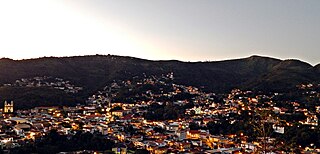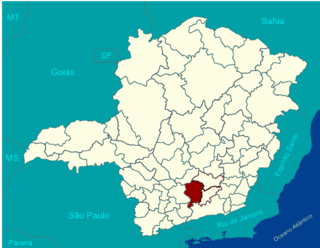
Ouro Preto, formerly Vila Rica, is a Brazilian municipality located in the state of Minas Gerais. The city, a former colonial mining town located in the Serra do Espinhaço mountains, was designated a World Heritage Site by UNESCO due to its Baroque colonial architecture. Ouro Preto used to be the capital of Minas Gerais from 1720 until the foundation of Belo Horizonte in 1897.

São João del-Rei is a Brazilian municipality in the state of Minas Gerais. Founded in 1713 in homage to king John V of Portugal, the city is famed for its historic Portuguese colonial architecture. The current population is estimated at 90,225 inhabitants.

Afonso Henrique da Costa Guimarães, known as Alphonsus de Guimaraens; was a Brazilian poet.

Bernardo Joaquim da Silva Guimarães was a Brazilian poet and novelist. He is the author of the famous romances A Escrava Isaura and O Seminarista. He also introduced to Brazilian poetry the verso bestialógico, also referred to as pantagruélico — poems whose verses are very nonsensical, although very metrical. Under the verso bestialógico, he wrote polemical erotic verses, such as "O Elixir do Pajé" and "A Origem do Mênstruo". A non-erotic poem written in verso bestialógico is "Eu Vi dos Polos o Gigante Alado".

Sabará is a Brazilian municipality located in the state of Minas Gerais. The city belongs to the Belo Horizonte metropolitan region and to the associated microregion.

The Archdiocese of São Paulo is a Latin Metropolitan Archbishopric of the Roman Catholic Church in Brazil.

Oliveira is a Brazilian municipality in the state of Minas Gerais. It is located at latitude 20º41'47" south and longitude 44º49'38" west, at an altitude of 982 metres. It is located 165 kilometres at southwest from Belo Horizonte. Its estimated population was 41,181 according to the latest IBGE census.

The Roman Catholic Archdiocese of Belo Horizonte is an archdiocese located in the city of Belo Horizonte in Brazil.

The Roman Catholic Archdiocese of Pouso Alegre is an archdiocese located in the city of Pouso Alegre in Brazil.

The Roman Catholic Diocese of São João da Boa Vista is a diocese located in the city of São João da Boa Vista in the ecclesiastical province of Ribeirão Preto in Brazil.
José Joaquim Emerico Lobo de Mesquita was a Brazilian composer, music teacher, conductor and organist.

Raymundo Damasceno Assis is a Brazilian cardinal of the Roman Catholic Church. He was Auxiliary Bishop of Brasília from 1986 to 2004 and Archbishop of Aparecida from 2004 to 2016.

The Immediate Geographic Region of Conselheiro Lafaiete is one of the 10 immediate geographic regions in the Intermediate Geographic Region of Barbacena, one of the 70 immediate geographic regions in the Brazilian state of Minas Gerais and one of the 509 of Brazil, created by the National Institute of Geography and Statistics (IBGE) in 2017.

The Immediate Geographic Region of São João del-Rei is one of the 10 immediate geographic regions in the Intermediate Geographic Region of Barbacena, one of the 70 immediate geographic regions in the Brazilian state of Minas Gerais and one of the 509 of Brazil, created by the National Institute of Geography and Statistics (IBGE) in 2017.

The colonial architecture of Brazil is defined as the architecture carried out in the current Brazilian territory from 1500, the year of the Portuguese arrival, until its Independence, in 1822.

The Church of Our Lady of the Rosary of Black Men, also known as the Church of Our Lady of the Rosary, is a Catholic temple in Ouro Preto, Minas Gerais, Brazil. Landmarked by IPHAN, it is one of the most original sacred buildings dating from the colonial period in Brazil.

















